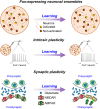Chasing the addicted engram: identifying functional alterations in Fos-expressing neuronal ensembles that mediate drug-related learned behavior
- PMID: 30115767
- PMCID: PMC6097770
- DOI: 10.1101/lm.046698.117
Chasing the addicted engram: identifying functional alterations in Fos-expressing neuronal ensembles that mediate drug-related learned behavior
Abstract
Given that addiction has been characterized as a disorder of maladaptive learning and memory, one critical question is whether there are unique physical adaptations within neuronal ensembles that support addiction-related learned behavior. The search for the physical mechanisms of encoding these and other memories in the brain, often called the engram as a whole, continues despite decades of research. As we develop new technologies and tools that allow us to study cue- and behavior-activated Fos-expressing neuronal ensembles, the possibility of identifying the engrams of learning and memory is moving into the realm of reality rather than speculation. It has become clear from recent studies that there are specific functional, electrophysiological alterations unique to Fos-expressing ensemble neurons that may participate in encoding memories. The ultimate goal is to identify the addicted engram and reverse the physical changes that support this maladaptive form of learning.
Published by Cold Spring Harbor Laboratory Press.
Figures

Similar articles
-
Using c-fos to study neuronal ensembles in corticostriatal circuitry of addiction.Brain Res. 2015 Dec 2;1628(Pt A):157-73. doi: 10.1016/j.brainres.2014.11.005. Epub 2014 Nov 11. Brain Res. 2015. PMID: 25446457 Free PMC article. Review.
-
Engram Size Varies with Learning and Reflects Memory Content and Precision.J Neurosci. 2021 May 5;41(18):4120-4130. doi: 10.1523/JNEUROSCI.2786-20.2021. Epub 2021 Apr 22. J Neurosci. 2021. PMID: 33888604 Free PMC article.
-
Functionally Distinct Neuronal Ensembles within the Memory Engram.Cell. 2020 Apr 16;181(2):410-423.e17. doi: 10.1016/j.cell.2020.02.055. Epub 2020 Mar 17. Cell. 2020. PMID: 32187527 Free PMC article.
-
Learning-associated astrocyte ensembles regulate memory recall.Nature. 2025 Jan;637(8045):478-486. doi: 10.1038/s41586-024-08170-w. Epub 2024 Nov 6. Nature. 2025. PMID: 39506118 Free PMC article.
-
All IEGs Are Not Created Equal-Molecular Sorting Within the Memory Engram.Adv Neurobiol. 2024;38:81-109. doi: 10.1007/978-3-031-62983-9_6. Adv Neurobiol. 2024. PMID: 39008012 Review.
Cited by
-
Thalamic Retrieval of Opioid Memories.Neuron. 2020 Sep 23;107(6):992-994. doi: 10.1016/j.neuron.2020.09.006. Neuron. 2020. PMID: 32971000 Free PMC article.
-
Hippocampal fear engrams modulate ethanol-induced maladaptive contextual generalization in mice.Hippocampus. 2022 Oct;32(10):707-715. doi: 10.1002/hipo.23463. Epub 2022 Aug 11. Hippocampus. 2022. PMID: 35950345 Free PMC article.
-
Cocaine-context memories are transcriptionally encoded in nucleus accumbens Arc ensembles.Nat Commun. 2025 Jul 2;16(1):6084. doi: 10.1038/s41467-025-61004-9. Nat Commun. 2025. PMID: 40603300 Free PMC article.
-
Cocaine and sucrose rewards recruit different seeking ensembles in the nucleus accumbens core.Mol Psychiatry. 2020 Dec;25(12):3150-3163. doi: 10.1038/s41380-020-00888-z. Epub 2020 Sep 28. Mol Psychiatry. 2020. PMID: 32985600 Free PMC article.
-
Astrocyte regulation of synaptic signaling in psychiatric disorders.Neuropsychopharmacology. 2023 Jan;48(1):21-36. doi: 10.1038/s41386-022-01338-w. Epub 2022 May 16. Neuropsychopharmacology. 2023. PMID: 35577914 Free PMC article. Review.
References
-
- Bliss TV, Collingridge GL. 1993. A synaptic model of memory: long-term potentiation in the hippocampus. Nature 361: 31–39. - PubMed
-
- Brami-Cherrier K, Roze E, Girault JA, Betuing S, Caboche J. 2009. Role of the ERK/MSK1 signalling pathway in chromatin remodelling and brain responses to drugs of abuse. J Neurochem 108: 1323–1335. - PubMed
Publication types
MeSH terms
Substances
LinkOut - more resources
Full Text Sources
Other Literature Sources
Medical
Research Materials
